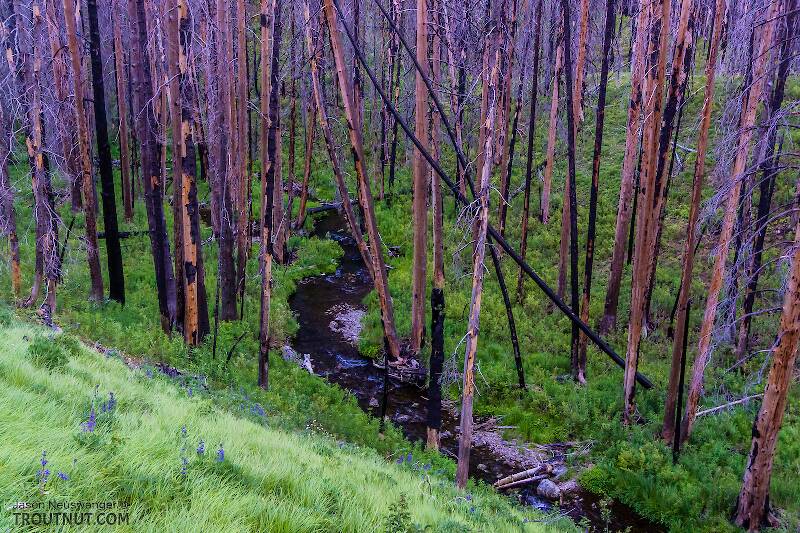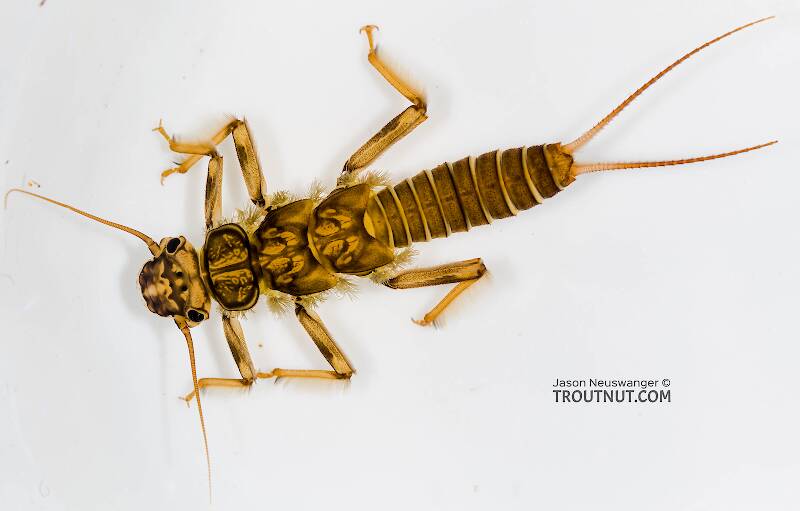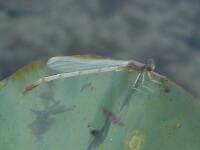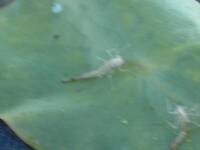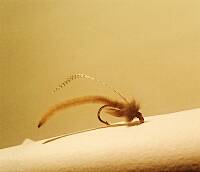
Hex Mayflies
Hexagenia limbata
The famous nocturnal Hex hatch of the Midwest (and a few other lucky locations) stirs to the surface mythically large brown trout that only touch streamers for the rest of the year.
Featured on the forum

Troutnut is a project started in 2003 by salmonid ecologist Jason "Troutnut" Neuswanger to help anglers and
fly tyers unabashedly embrace the entomological side of the sport. Learn more about Troutnut or
support the project for an enhanced experience here.
Mind2it on Mar 23, 2008March 23rd, 2008, 2:00 pm EDT
How does water temperature specifically affect trout insect hatches?
Do certain insects trend toward hatching at a specific water temperature?
At what water temperature range do trout generally begin to become active top feeders?
Would the time of day affect water temp?
Do certain insects trend toward hatching at a specific water temperature?
At what water temperature range do trout generally begin to become active top feeders?
Would the time of day affect water temp?
RE: Ideal water temps for top water feeding trout.
Taxon on Mar 23, 2008March 23rd, 2008, 4:15 pm EDT
Mind2it-
Aquatic insect immatures require a specific cumulative thermal regimen to attain maturity. This is customarily measured in degree-days. Without getting unnecessarily technical, each day the water temperature averages above the minimum threshold for growth, an aquatic insect living in it is considered to accumulate the number of degree-days by which the average temperature exceeds that threshold. For example, if the threshold were 34 degrees, and the average water temperature for the day were 39 degrees, any insect immature in that water would have accumulated 5 degree-days. So, if a particular species were to require 500 degree-days of cumulative thermal regimen in order to attain maturity, it would require 100 days at that average temperature to do so. Of course it would be nice if there were a cumulative degree-days requirement published for every aquatic insect species of interest to flyfishers. However, it seems this information is mostly known for the terrestrial insect pest species which negatively impact agriculture, particularly fruit trees.
Yes, there are numerous useful rules of thumb, particularly for some of the more popular mayfly emergences. And of course, the reason they are so useful is that, we have neither a good understanding of the degree-days required for most aquatic insect species to mature, nor a practical way of measuring cumulative degree-days for a particular piece of water.
I seem to recall it being said to be in the low 50s, but I’m not sure how useful that number is, as trout will actively surface-feed on emerging BWOs when water temperatures are still in the mid 30s.
Most certainly, particularly on those days when a significant difference exists between nighttime and daytime temperatures. Of course, this effect is largely negated on spring creeks, particularly in downstream proximity to their subterranean source(s).
How does water temperature specifically affect trout insect hatches?
Aquatic insect immatures require a specific cumulative thermal regimen to attain maturity. This is customarily measured in degree-days. Without getting unnecessarily technical, each day the water temperature averages above the minimum threshold for growth, an aquatic insect living in it is considered to accumulate the number of degree-days by which the average temperature exceeds that threshold. For example, if the threshold were 34 degrees, and the average water temperature for the day were 39 degrees, any insect immature in that water would have accumulated 5 degree-days. So, if a particular species were to require 500 degree-days of cumulative thermal regimen in order to attain maturity, it would require 100 days at that average temperature to do so. Of course it would be nice if there were a cumulative degree-days requirement published for every aquatic insect species of interest to flyfishers. However, it seems this information is mostly known for the terrestrial insect pest species which negatively impact agriculture, particularly fruit trees.
Do certain insects trend toward hatching at a specific water temperature?
Yes, there are numerous useful rules of thumb, particularly for some of the more popular mayfly emergences. And of course, the reason they are so useful is that, we have neither a good understanding of the degree-days required for most aquatic insect species to mature, nor a practical way of measuring cumulative degree-days for a particular piece of water.
At what water temperature range do trout generally begin to become active top feeders?
I seem to recall it being said to be in the low 50s, but I’m not sure how useful that number is, as trout will actively surface-feed on emerging BWOs when water temperatures are still in the mid 30s.
Would the time of day affect water temp?
Most certainly, particularly on those days when a significant difference exists between nighttime and daytime temperatures. Of course, this effect is largely negated on spring creeks, particularly in downstream proximity to their subterranean source(s).
Shawnny3 on Mar 23, 2008March 23rd, 2008, 11:25 pm EDT
Thank you, Mind2it, for asking the questions, and thank you, Roger, for answering them. Good stuff for we who are more bug-ignorant.
-Shawn
-Shawn
Jewelry-Quality Artistic Salmon Flies, by Shawn Davis
www.davisflydesigns.com
www.davisflydesigns.com
CaseyP on Mar 24, 2008March 24th, 2008, 5:24 am EDT
thanks, Taxon, for your clear explanation. in the days we had oil heat, the truck would show up when we needed oil, some months more frequently than others. we never ran out of oil, and the truck never came unnecessarily. once i asked the short tempered gent who brought it how he knew when to come, and he grunted "degree days," shouldered his hose, and left with no further explanation.
thanks for the "further explanation"!
thanks for the "further explanation"!
"You can observe a lot by watching." Yogi Berra
U2ill on Apr 2, 2008April 2nd, 2008, 10:14 am EDT
Where would I find information about degree-days for particular species of stream insects (caddis, mayflies, and stoneflies)?
Softhackle on Apr 2, 2008April 2nd, 2008, 3:11 pm EDT
Hi everyone,
I would be in no position to argue with Taxon regarding the information given. I'm sure it's pretty solidly based in scientific information of which I have much less knowledge than he does.
I have read, and I believe it was from Len Wright, Jr, who conducted a number of experiments regarding when trout feed, and much of the information was with regard to water temperature. Mr. Wright found, and I concur from my experience since I read his findings, that as water temperature approaches 63 degrees F, the trout are most actively feeding. This can be from either direction--rising to or falling to that temperature. Likewise, the highest insect activity also took place at that temperature. It seems mother nature always coincides occurances to work together.
I'm sure, as Taxon has pointed out, there are exceptions to this general rule. I do feel, however, that insect activity and trout feeding are affected by a number of different variables such as water temp, clarity & speed.(I see in another posting that Taxon is in agreement, here as well.) We have to remember that trout are cold blooded, and their metabolism slows greatly in colder water, so they don't need to eat as much.
A good example of the variables occurs on my river. Around this time of year, as in many streams and rivers, we get a great hatch of early black stone flies. These flies are very prolific where I live, but I have only had the experience of a few times of actually catching trout during their hatch. Generally the water is often too cold, too muddy and too fast for the trout to feed on them. The times I've actually been successful during this hatch is when the water was clearer, lower and slower and somewhat warmer because of this. The trout actively took imitations of these flies.
It's great to know the hatch times of certain insects so we can anticipate feeding activity, but just because we know the flies might be there does not necessarily mean they'll become trout food. We can only hope.
Mark
I would be in no position to argue with Taxon regarding the information given. I'm sure it's pretty solidly based in scientific information of which I have much less knowledge than he does.
I have read, and I believe it was from Len Wright, Jr, who conducted a number of experiments regarding when trout feed, and much of the information was with regard to water temperature. Mr. Wright found, and I concur from my experience since I read his findings, that as water temperature approaches 63 degrees F, the trout are most actively feeding. This can be from either direction--rising to or falling to that temperature. Likewise, the highest insect activity also took place at that temperature. It seems mother nature always coincides occurances to work together.
I'm sure, as Taxon has pointed out, there are exceptions to this general rule. I do feel, however, that insect activity and trout feeding are affected by a number of different variables such as water temp, clarity & speed.(I see in another posting that Taxon is in agreement, here as well.) We have to remember that trout are cold blooded, and their metabolism slows greatly in colder water, so they don't need to eat as much.
A good example of the variables occurs on my river. Around this time of year, as in many streams and rivers, we get a great hatch of early black stone flies. These flies are very prolific where I live, but I have only had the experience of a few times of actually catching trout during their hatch. Generally the water is often too cold, too muddy and too fast for the trout to feed on them. The times I've actually been successful during this hatch is when the water was clearer, lower and slower and somewhat warmer because of this. The trout actively took imitations of these flies.
It's great to know the hatch times of certain insects so we can anticipate feeding activity, but just because we know the flies might be there does not necessarily mean they'll become trout food. We can only hope.
Mark
"I have the highest respect for the skilled wet-fly fisherman, as he has mastered an art of very great difficulty." Edward R. Hewitt
Flymphs, Soft-hackles and Spiders: http://www.troutnut.com/libstudio/FS&S/index.html
Flymphs, Soft-hackles and Spiders: http://www.troutnut.com/libstudio/FS&S/index.html
Taxon on Apr 2, 2008April 2nd, 2008, 6:04 pm EDT
U2ill-
You would look for studies published in scientific journals. However, my belief is, there is really not much out there to find, even if one had subscription access to those journals, which I do not. The obvious conclusion? This is simply not the type of information which attracts funding of studies.
Where would I find information about degree-days for particular species of stream insects (caddis, mayflies, and stoneflies)?
You would look for studies published in scientific journals. However, my belief is, there is really not much out there to find, even if one had subscription access to those journals, which I do not. The obvious conclusion? This is simply not the type of information which attracts funding of studies.
Falsifly on Apr 3, 2008April 3rd, 2008, 3:07 am EDT
For further explanation of degree-days.
http://www.ipm.ucdavis.edu/WEATHER/ddconcepts.html
http://www.ipm.ucdavis.edu/WEATHER/ddconcepts.html
Falsifly
When asked what I just caught that monster on I showed him. He put on his magnifiers and said, "I can't believe they can see that."
When asked what I just caught that monster on I showed him. He put on his magnifiers and said, "I can't believe they can see that."
Leakywaders on Jun 15, 2008June 15th, 2008, 3:41 am EDT
Once upon a time I had a tropical fish aquarium. I was accustomed to feed the fish every night when I came home from work. One feeding the fish gobbled up the usual amount of food, and more. I also noticed they were FAR more active than usual. A few hours they were floating on the surface, belly up. They were poached. It seems my wife had turned the heater up while dusting.
In Rick Tayler's book (Don't remember the title right now, and can't find it, its about Bass) he talks about temperature. He says to wait for a three day warming trend the call in sick on the third day, and go fishing. If you read between the lines... It seems that the temp is not as important as the CHANGE in temp.
If you watch the Bass fishing shows you will notice that whenever they catch fish the air temp is higher than the water temp thus the water temp is rising.
In TROUT Ray Bergman says that he always cought the most fish in the warmest part of the day. i.e. when air temp was above water temp.
Ever notice that grasshoppers don't jump around a lot in the cool of early morning??
I'm leading up to what I think os a general rule here, not sure if it is true. As the temp rises cold blooded creatures increase in activity, up to some optimum for that specises. The faster the rise in temp the greater the increses in activity. When the optimum is exceeded, obviously they cook. Drops in temp (you NEVER see them catching bass when the air temp is lower than the water temp - the dreded cold front) stop feeding. Why are we always talking about the absolute temp, and not the RELATIVE temp, or the CHANGE in temp? OK, so nobody knows the water temp the days before they went fishing. Well, if the air temp is higher than the water temp, the water temp is rising.
Does this match other's experience???
In Rick Tayler's book (Don't remember the title right now, and can't find it, its about Bass) he talks about temperature. He says to wait for a three day warming trend the call in sick on the third day, and go fishing. If you read between the lines... It seems that the temp is not as important as the CHANGE in temp.
If you watch the Bass fishing shows you will notice that whenever they catch fish the air temp is higher than the water temp thus the water temp is rising.
In TROUT Ray Bergman says that he always cought the most fish in the warmest part of the day. i.e. when air temp was above water temp.
Ever notice that grasshoppers don't jump around a lot in the cool of early morning??
I'm leading up to what I think os a general rule here, not sure if it is true. As the temp rises cold blooded creatures increase in activity, up to some optimum for that specises. The faster the rise in temp the greater the increses in activity. When the optimum is exceeded, obviously they cook. Drops in temp (you NEVER see them catching bass when the air temp is lower than the water temp - the dreded cold front) stop feeding. Why are we always talking about the absolute temp, and not the RELATIVE temp, or the CHANGE in temp? OK, so nobody knows the water temp the days before they went fishing. Well, if the air temp is higher than the water temp, the water temp is rising.
Does this match other's experience???
Drag free??? If the fly didn't drag, I wouldn't know where it was!!
Quick Reply
Related Discussions
Topic
Replies
Last Reply
1
Jul 28, 2006
by Wiflyfisher
by Wiflyfisher
1
Jul 11, 2008
by Taxon
by Taxon

